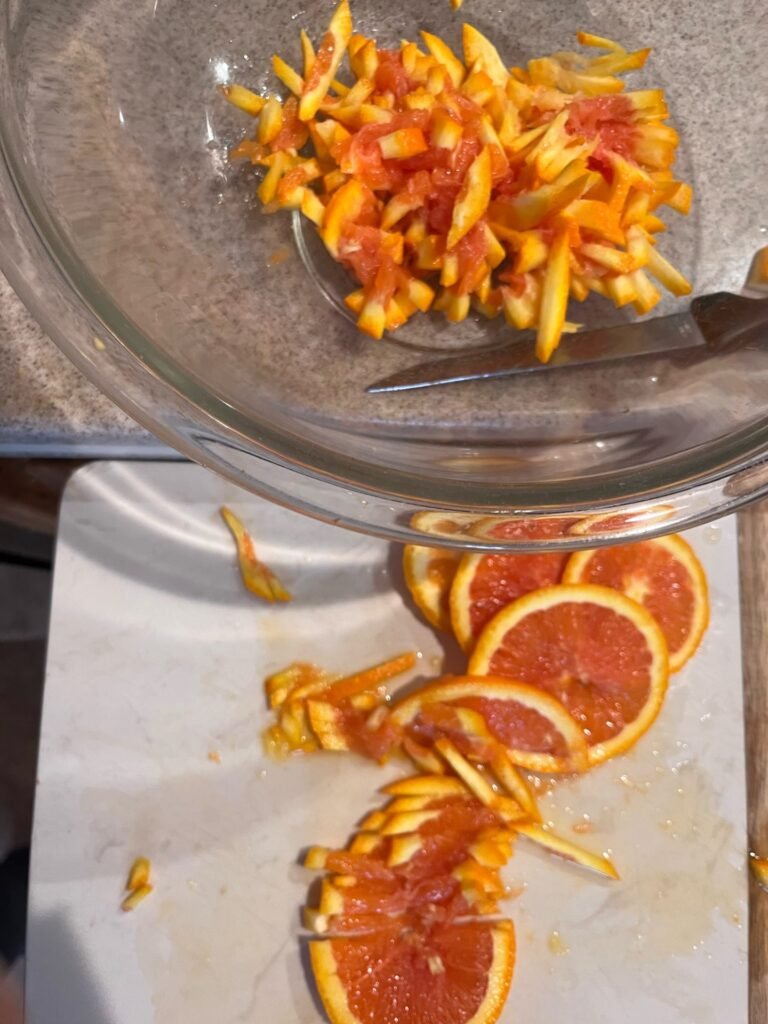
I have loved orange marmalade forever. I never imagined that I would make it. It seemed time consuming, and I didn’t trust myself with the canning process. The more I have learned, through Ray Peat’s work the more I realized I need to learn to make marmalade. Besides the added pectin and citric acid that I don’t want in my jams, a good one cup jar of marmalade costs me around ten dollars. I go go through that jar in less than a week, and sometimes it is gone in a matter of days.
So I set out to make marmalade. I discovered that citrus fruits as well as other fruits have their own pectin. Cutting these fruits and soaking them overnight draws that pectin out. So to start this recipe you’ll need 3 medium to large oranges. Choose oranges with thinner skins. I made this batch, shown in the picture, with two Cara Cara oranges and, because I didn’t have a third I substituted two mandarins instead.

Slice the oranges fairly thin, and then cut those thin slices across the diameter of the slices. Transfer these slices into a bowl along with four cups of filtered water. Cover the bowl and let sit in the refrigerator for about 24 hours.

To finish making this marmalade, pour the soaked oranges into a non-reactive pot, and cook uncovered for a half hour on medium to medium high heat, depending on the pot you use. After that half hour, add in two to three cups of sugar, depending on the sweetness of your oranges and cook for another thirty minutes, stirring here and there. Right when I turn off the heat I stir in about a tablespoon of lemon juice, real citric acid not the black mold lab made stuff in jams and jellies and everything else nowadays. At this point the marmalade is done. It can be canned, or just kept in the refrigerator. I have made this with a mix of citrus fruits, like Meyer’s lemon and pink grapefruit. You could add in vanilla, or other fruits as well. The batch I made before this one was a pink grapefruit and Golden Berry marmalade. I use marmalade to sweeten my chamomile tea, have it on cottage cheese and yogurt, or use it in savory dishes to make sweet sauces for shrimp, scallops and lamb. Oh yeah, and you could put it on toast, sourdough of course!
“When I get sour oranges I make marmalade from the peels, if they are organic. Shred, soak, cook slowly simmering in water for about an hour before adding sugar, and letting that simmer without boiling until it thickens a little. When it’s cool it thickens more. The peels are rich in anti-inflammatory chemicals, more than the juice, and the marmalade is a good way to get sugar with the cottage cheese or parmesan.“ -Ray Peat






Nice job getting the website up..
Cheers!
Thank you Bob! I’m still learning, and not a natural tech person, but our site will get better and better. Thankfully over the last couple of days I am getting more proficient at inputting content. I appreciate any input, good and not so good.
I absolutely love Marmelade, my MIL always cooks up a big batch and then freezes the jars, instead of relying on sterilisation. Works really well!
This is good to know. Do you freeze it in glass jars? I recently froze my son’s homemade mango habanero sauce and one of the glass bottles cracked open.
Mine burned! I guess my med high was too high. I used a Corning ware pot and it stuck to the bottom even with the stirring. I’ll try again making some adjustments.
My second time making marmalade that happened, because my oranges had thicker skins and were not as juicy. Mine was not burned, but was more caramelized and thicker, and still delicious. You can always add water if you see it is getting too thick. I can tell after it has sat overnight, before I start cooking it, that the water is sometimes thicker than other times. You can always add juice to it too to change things up! I use a Le Creuset pot.
I’m making my second batch. I’m so pleased you put up this recipe.
Thank you!
I am so glad to hear that you appreciate this amazing marmalade as much as I do. I need to make some more as it has been awhile. I use it in so many ways. You inspired me to make this in the next few days so thank you too Bee!
Thanks for letting me know this Barb. I went back in the recipe instructions to let people know that the heat is dependent on the pot they use.